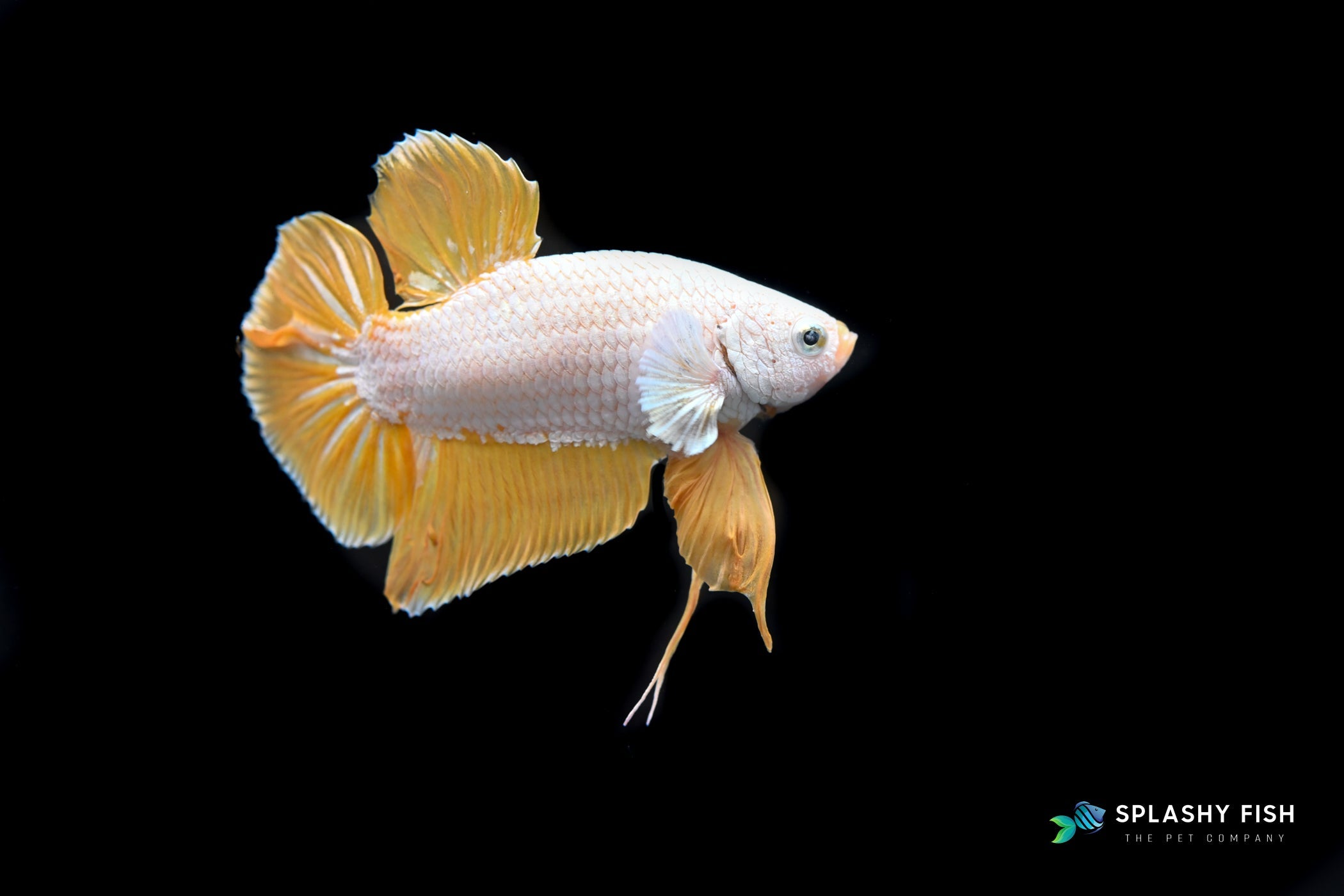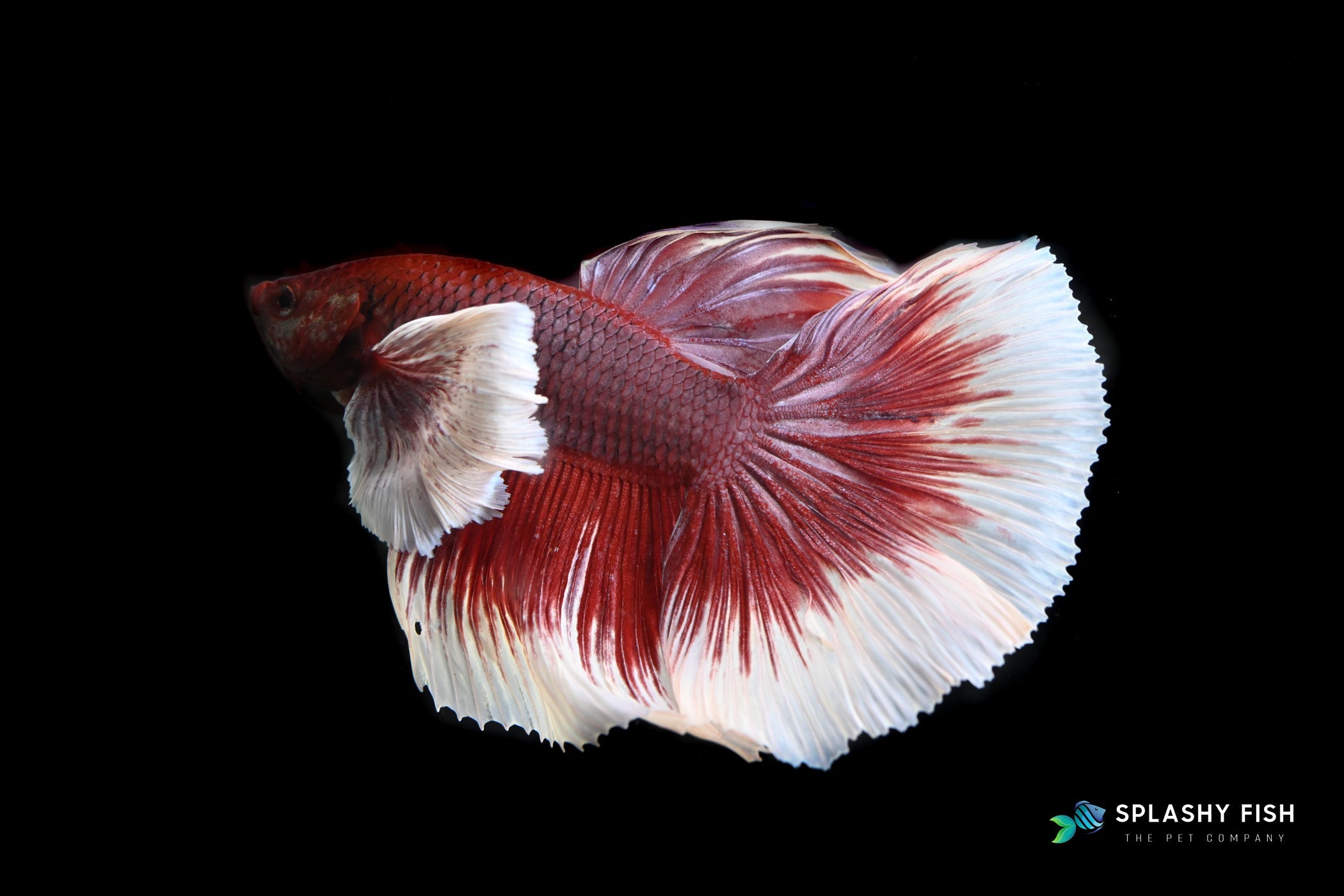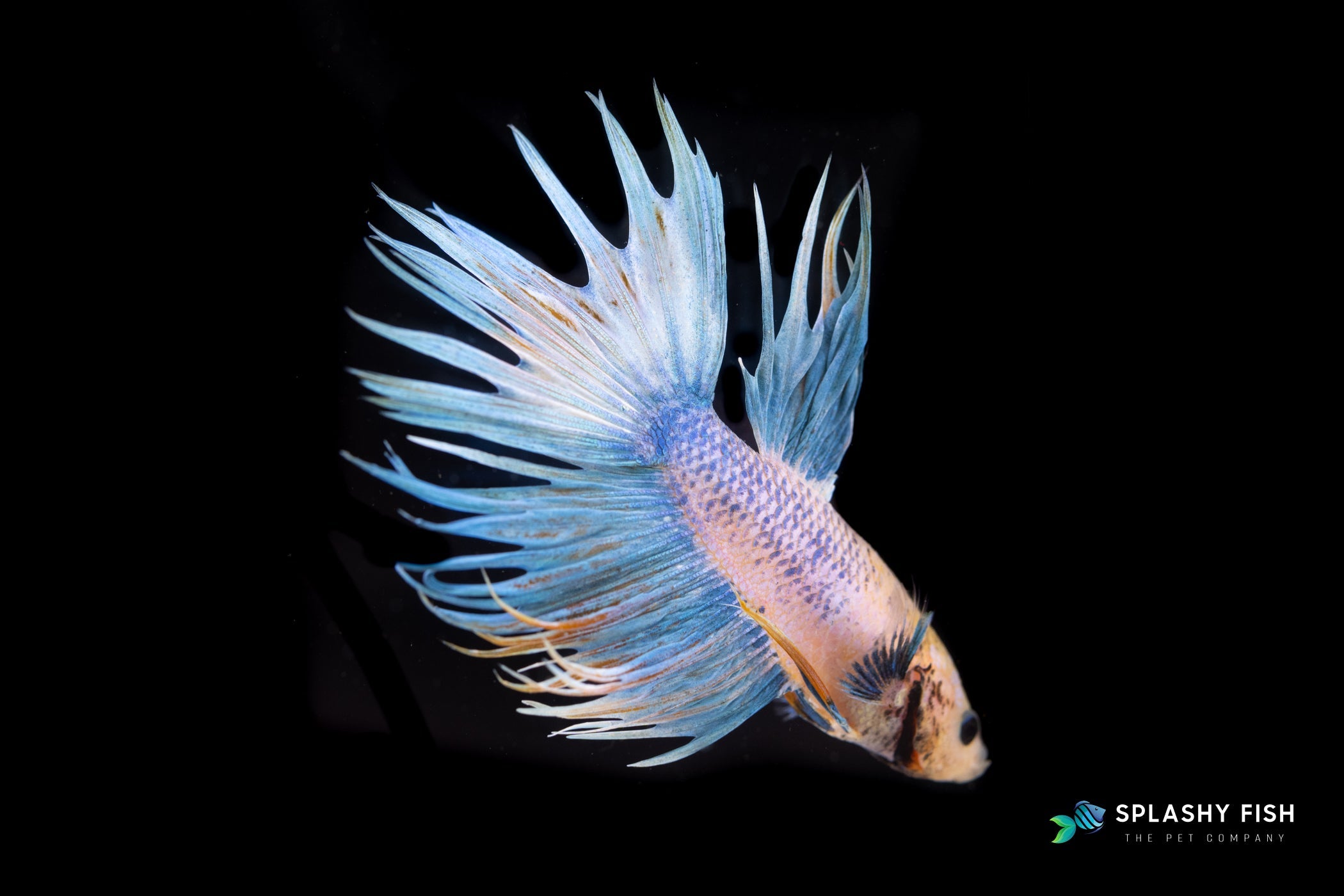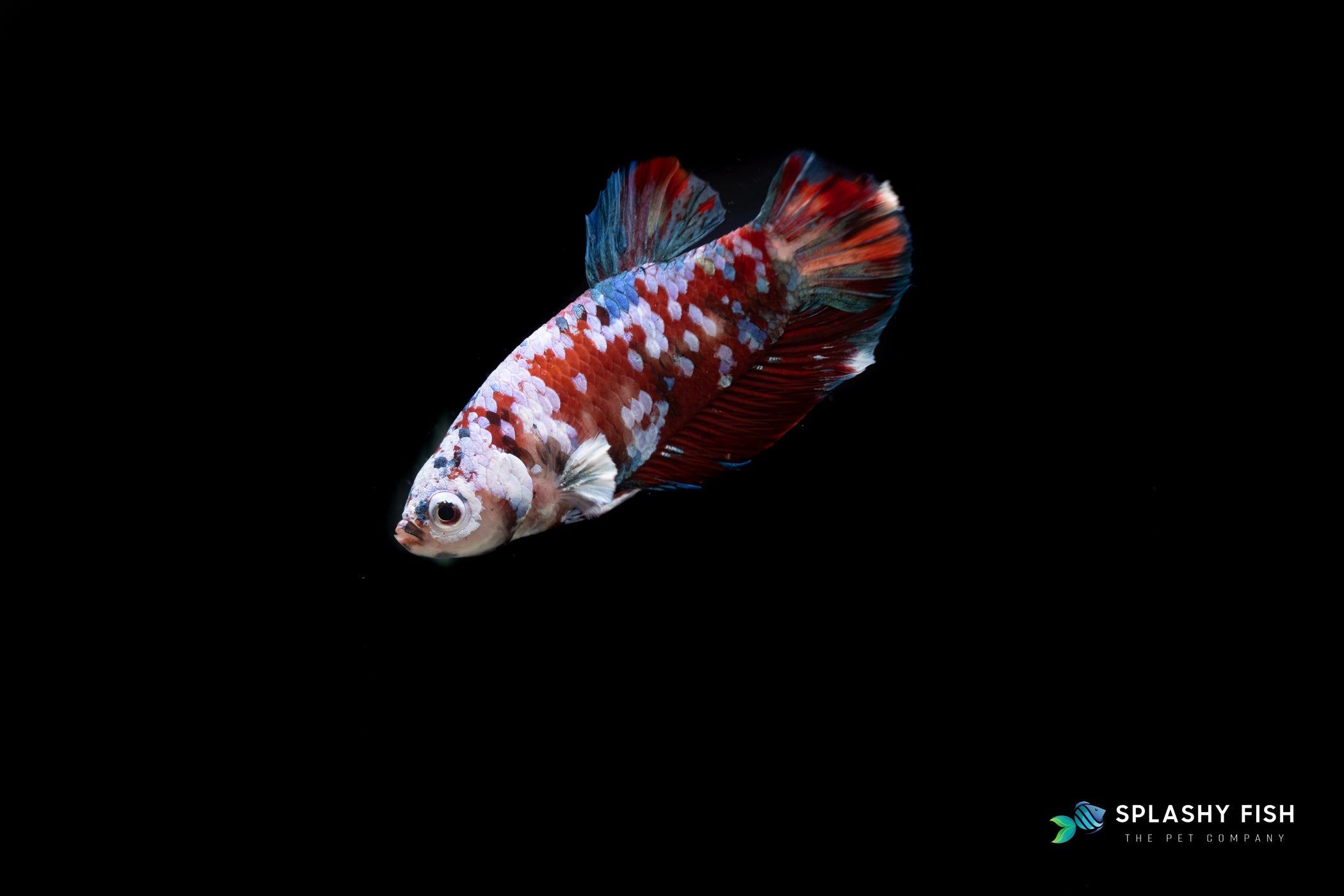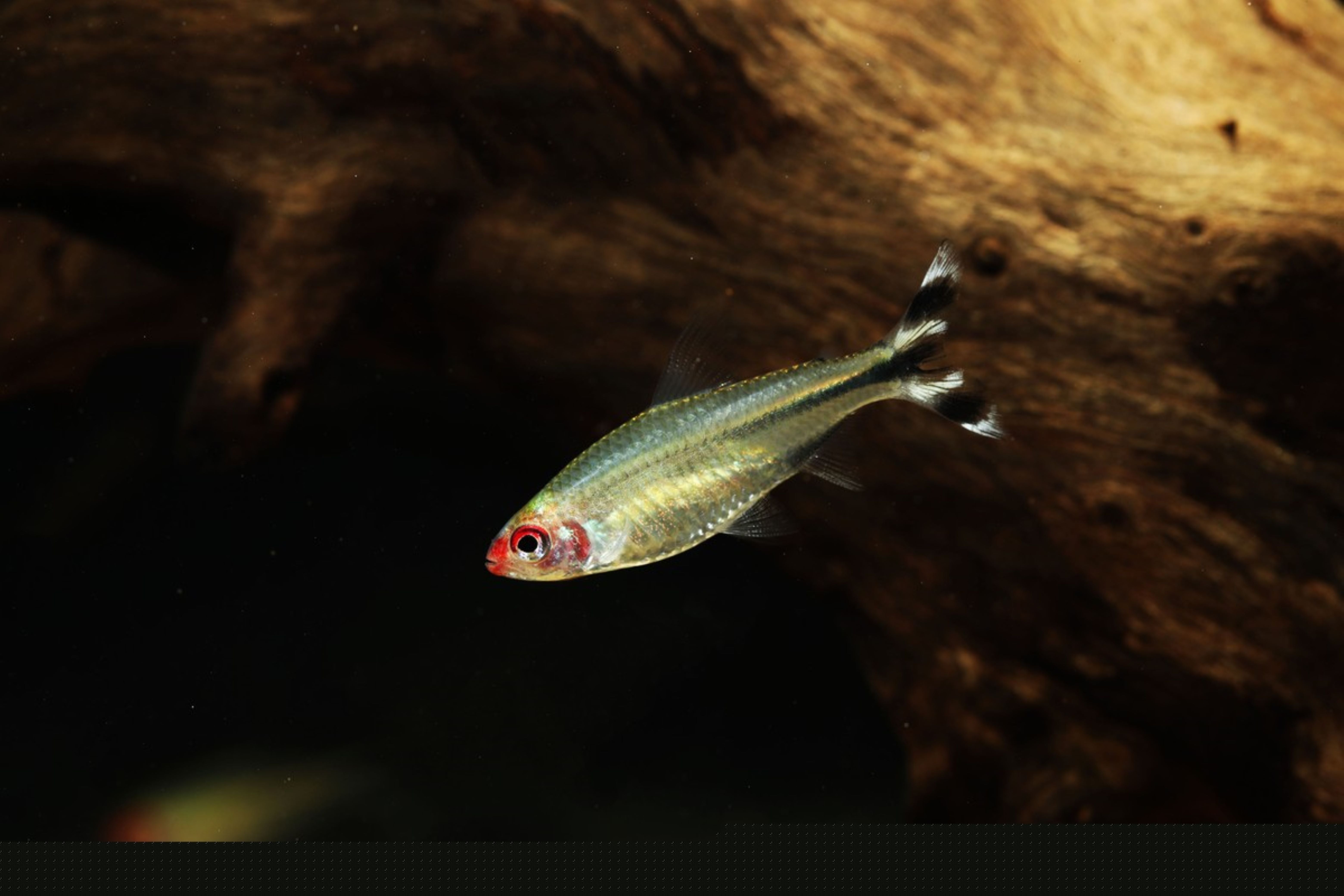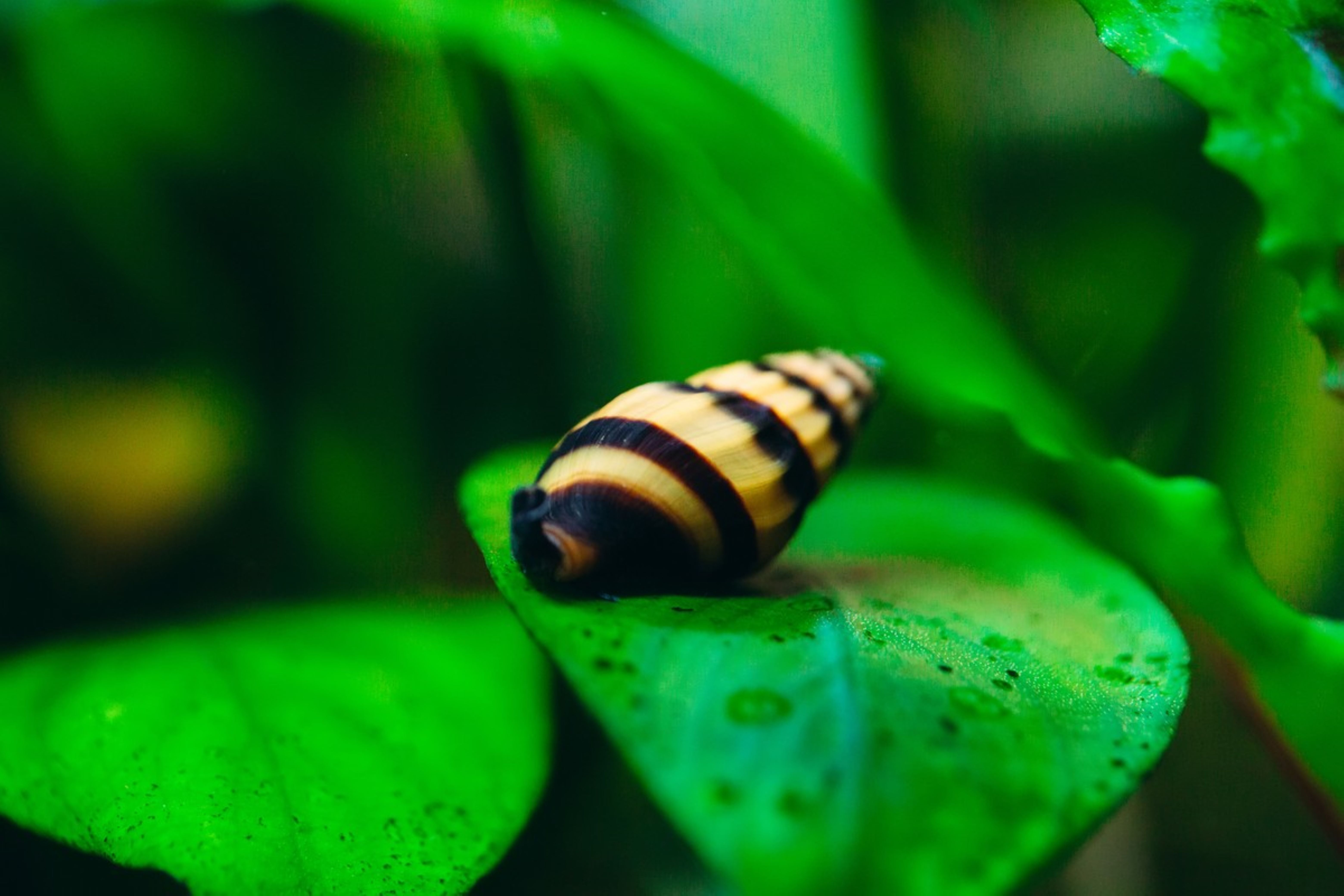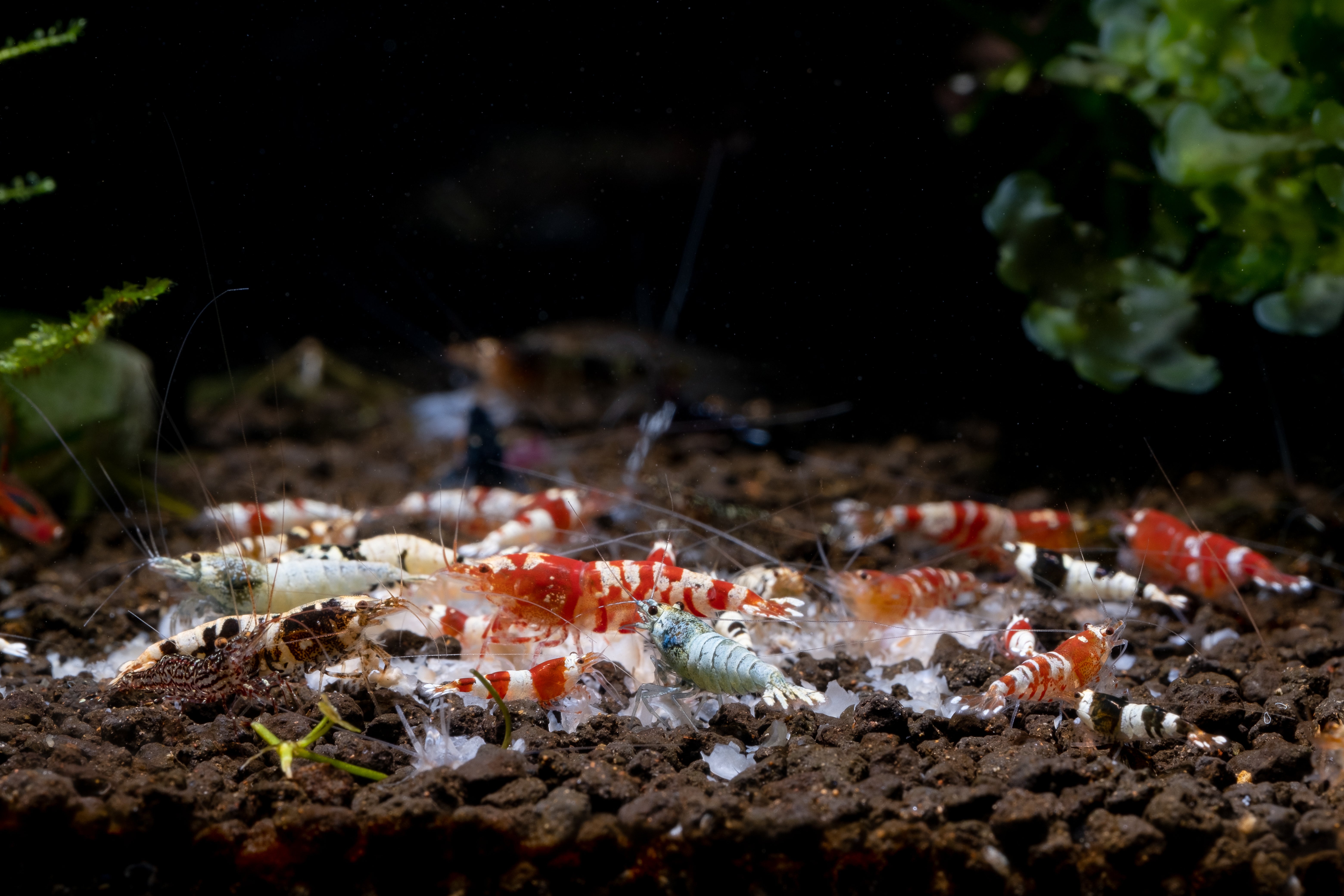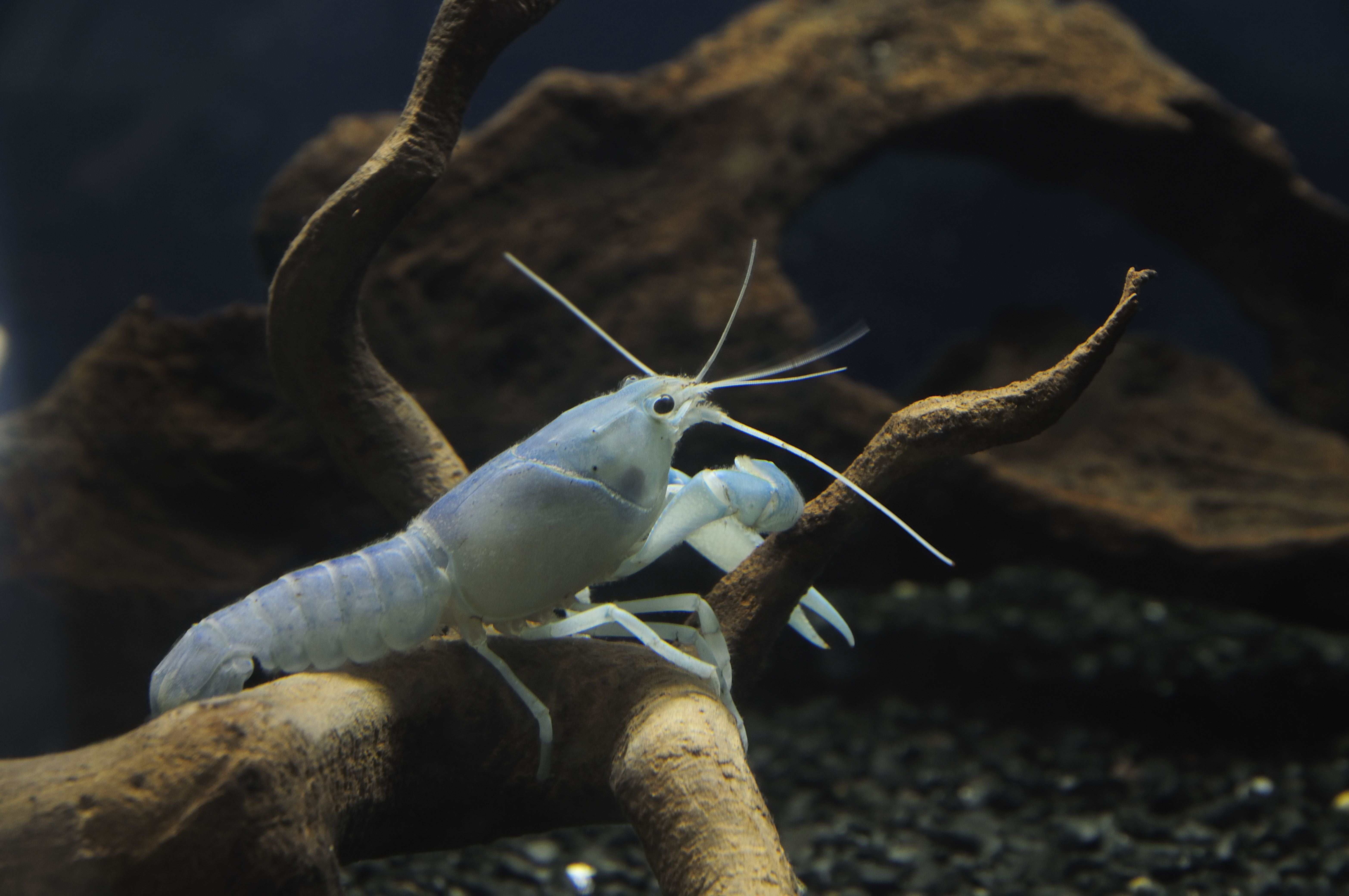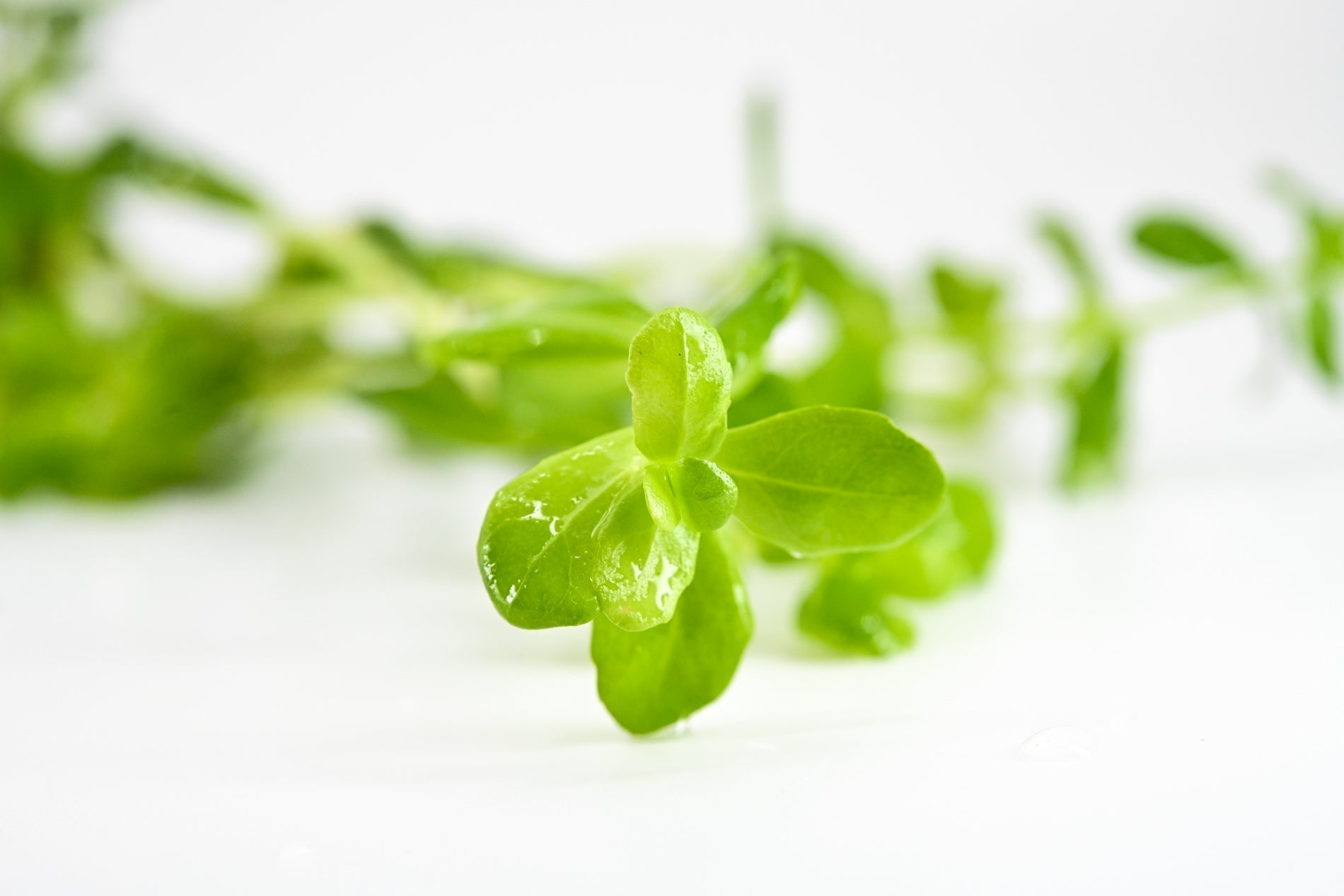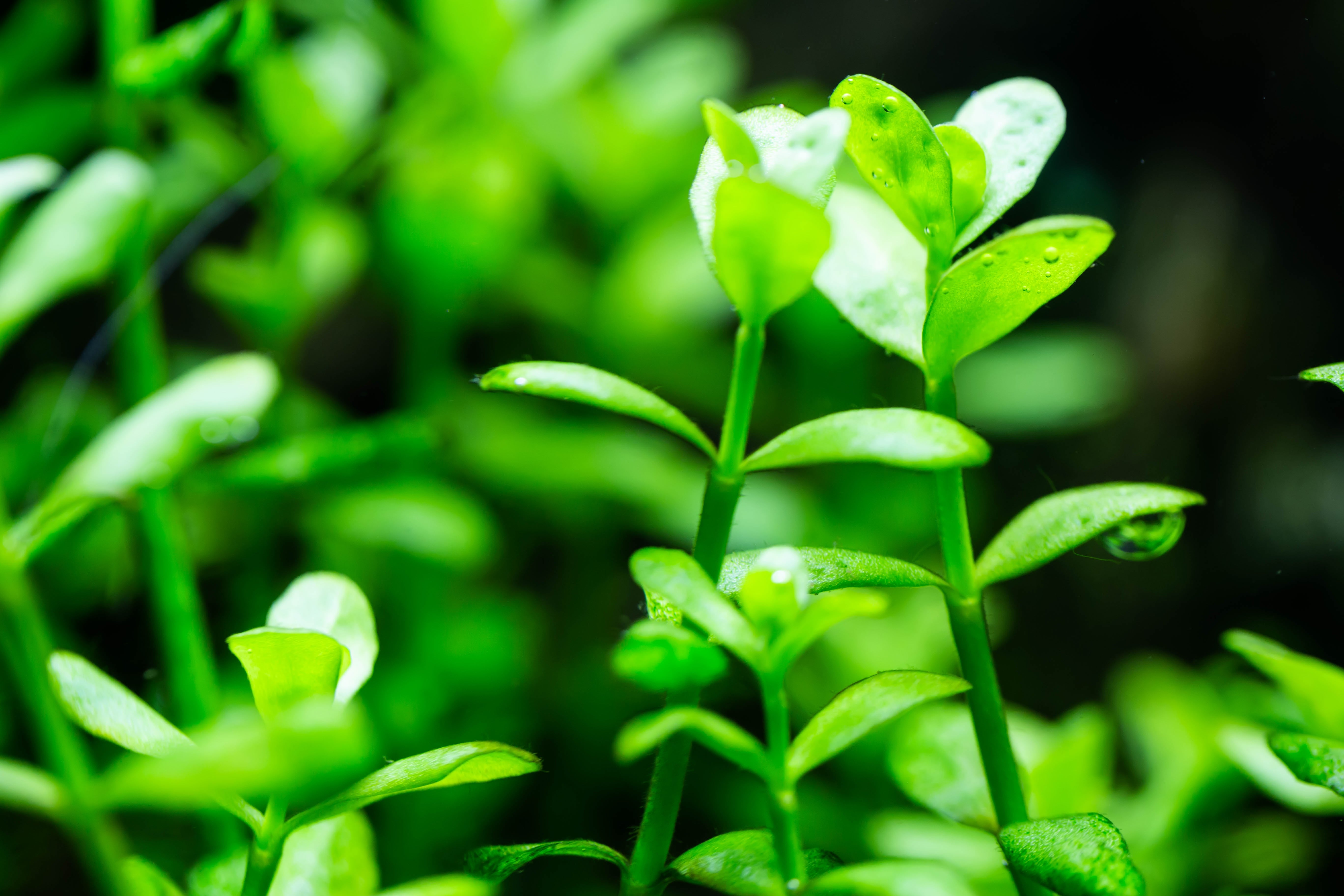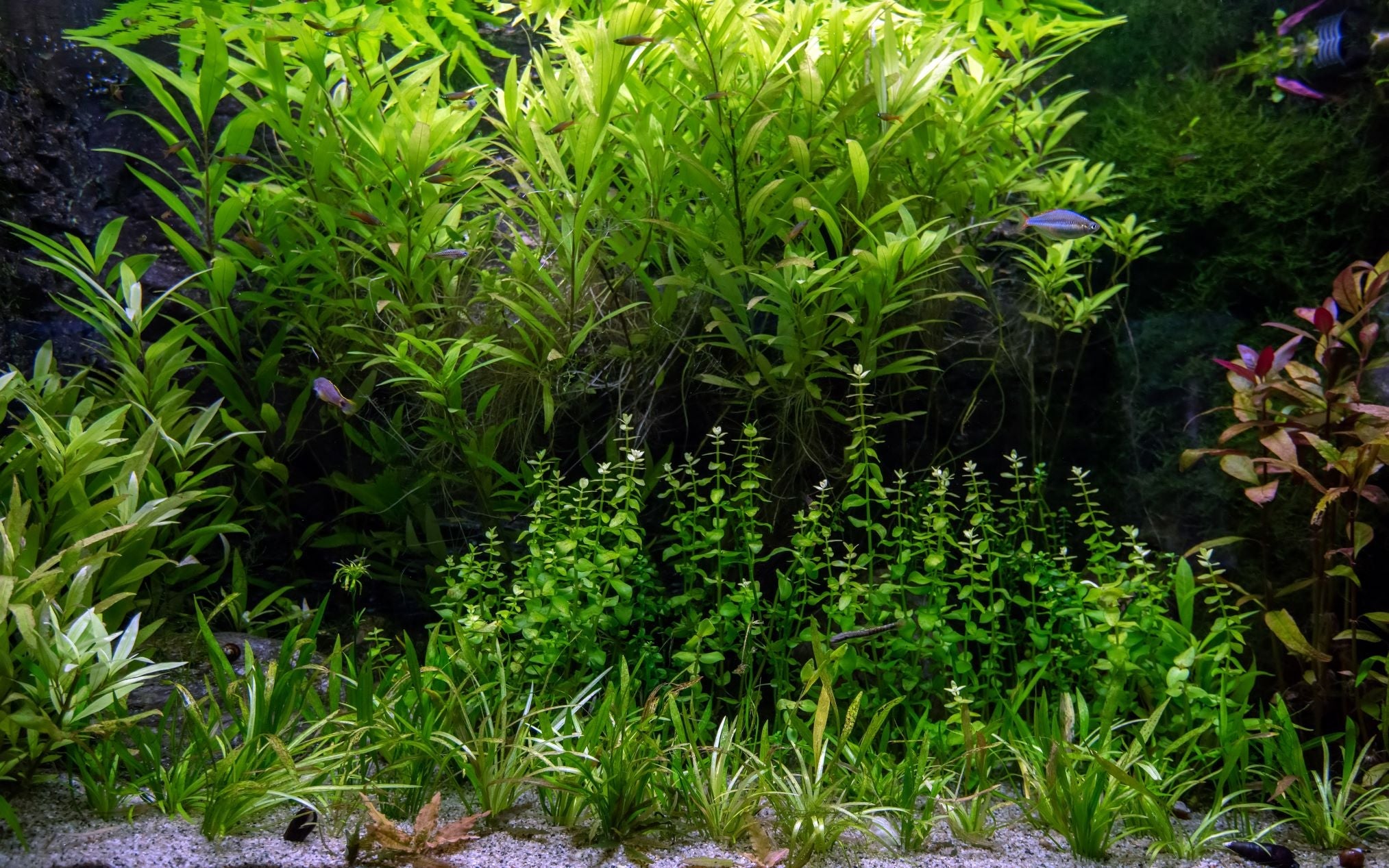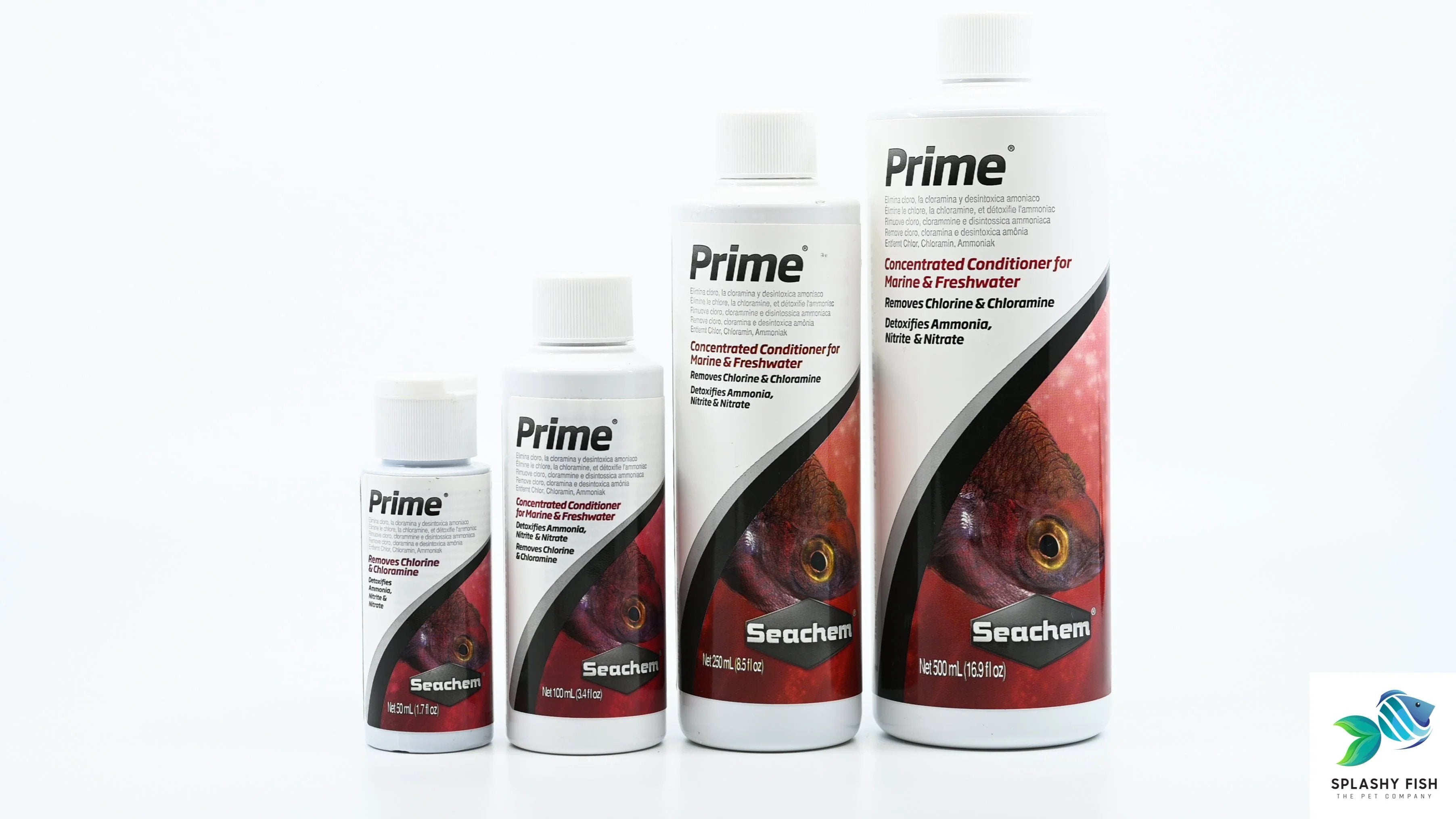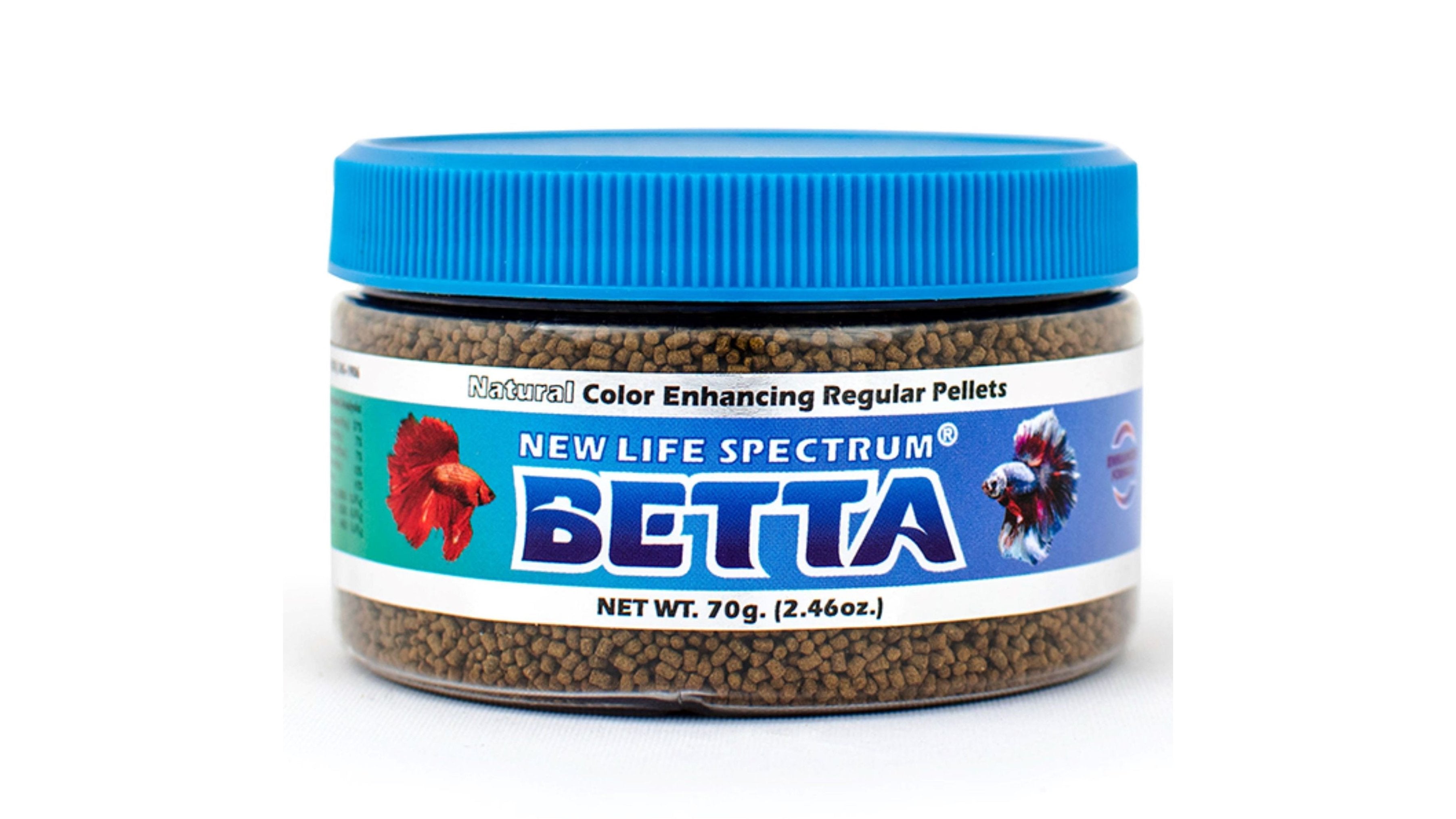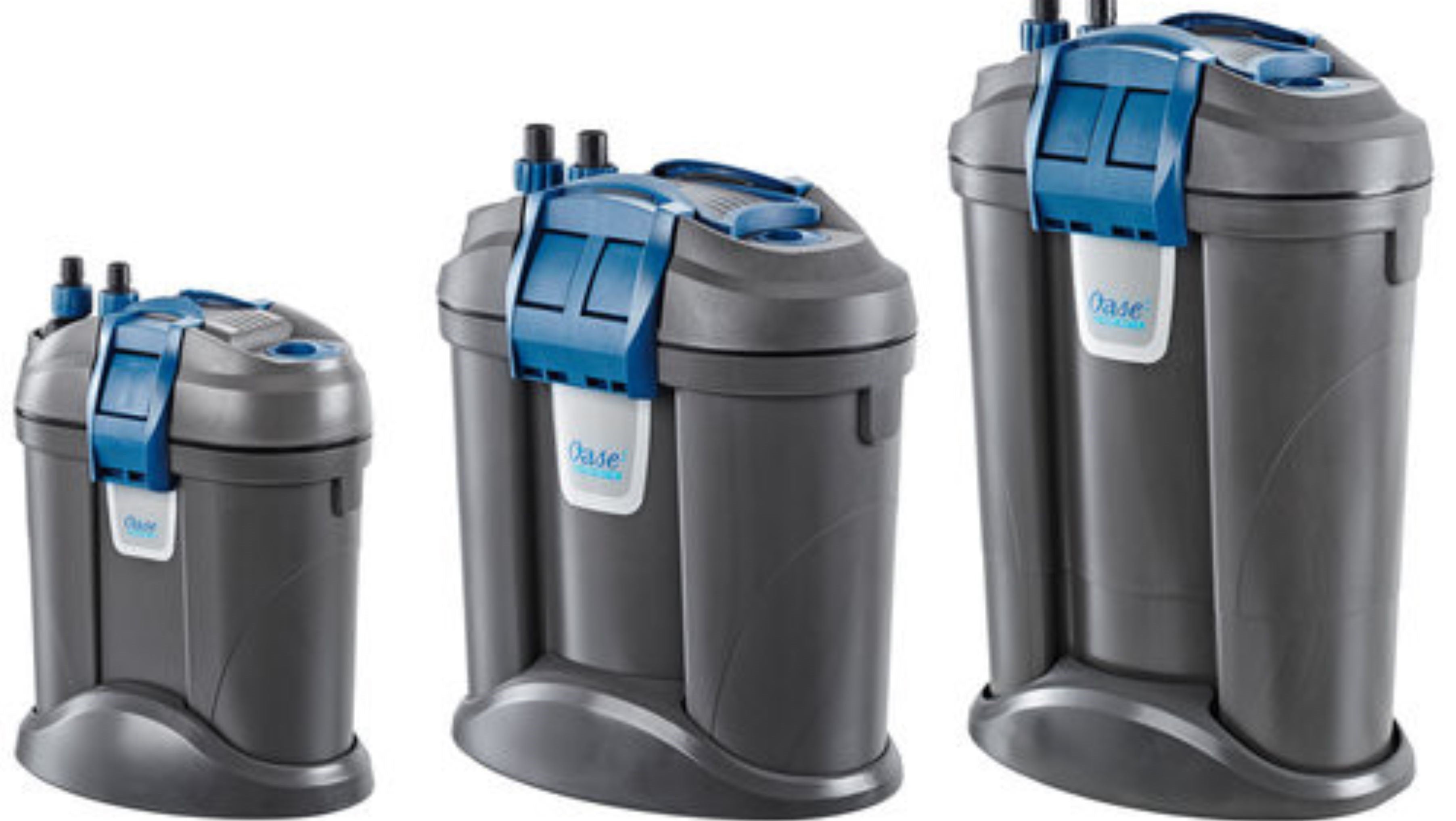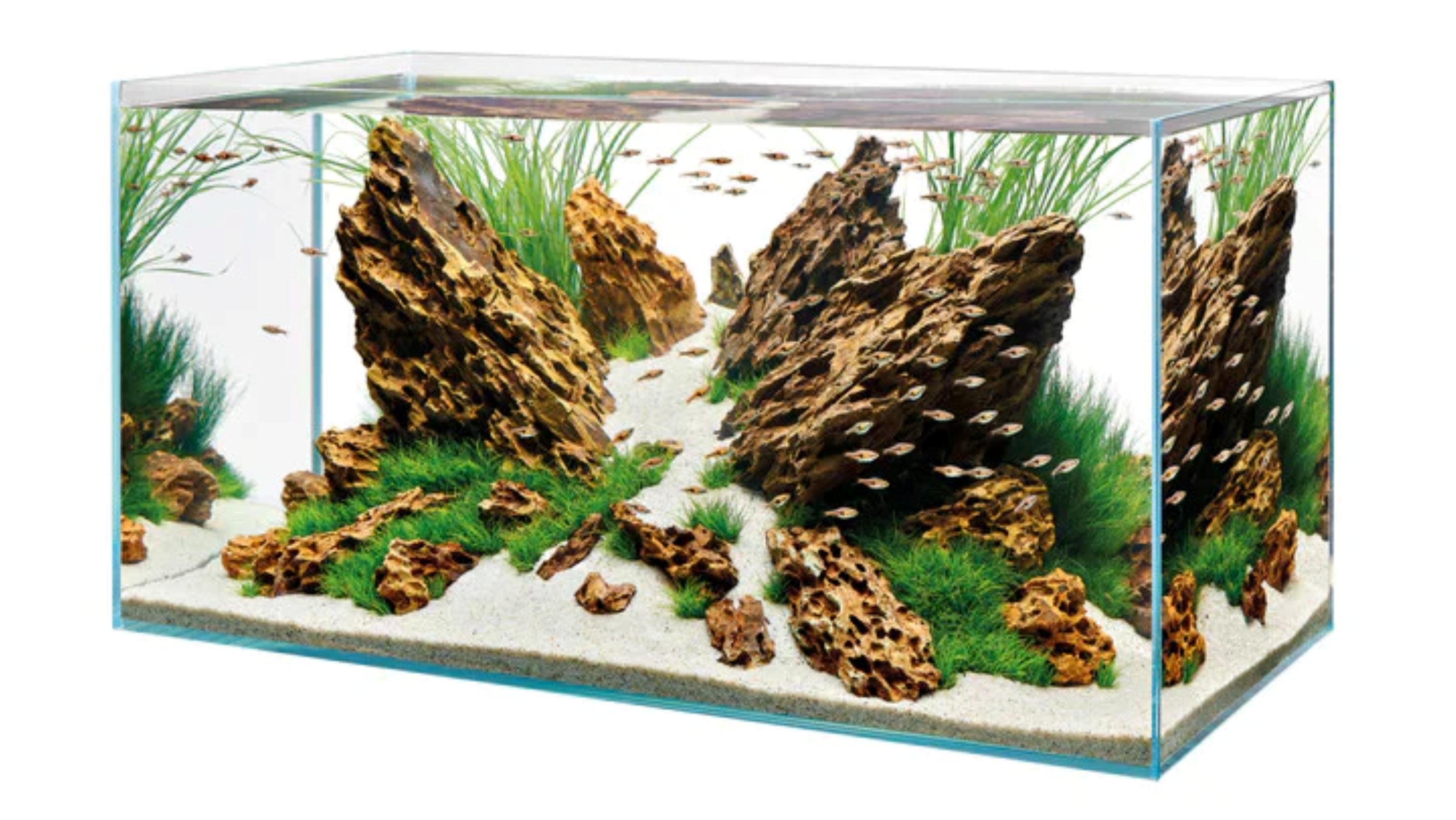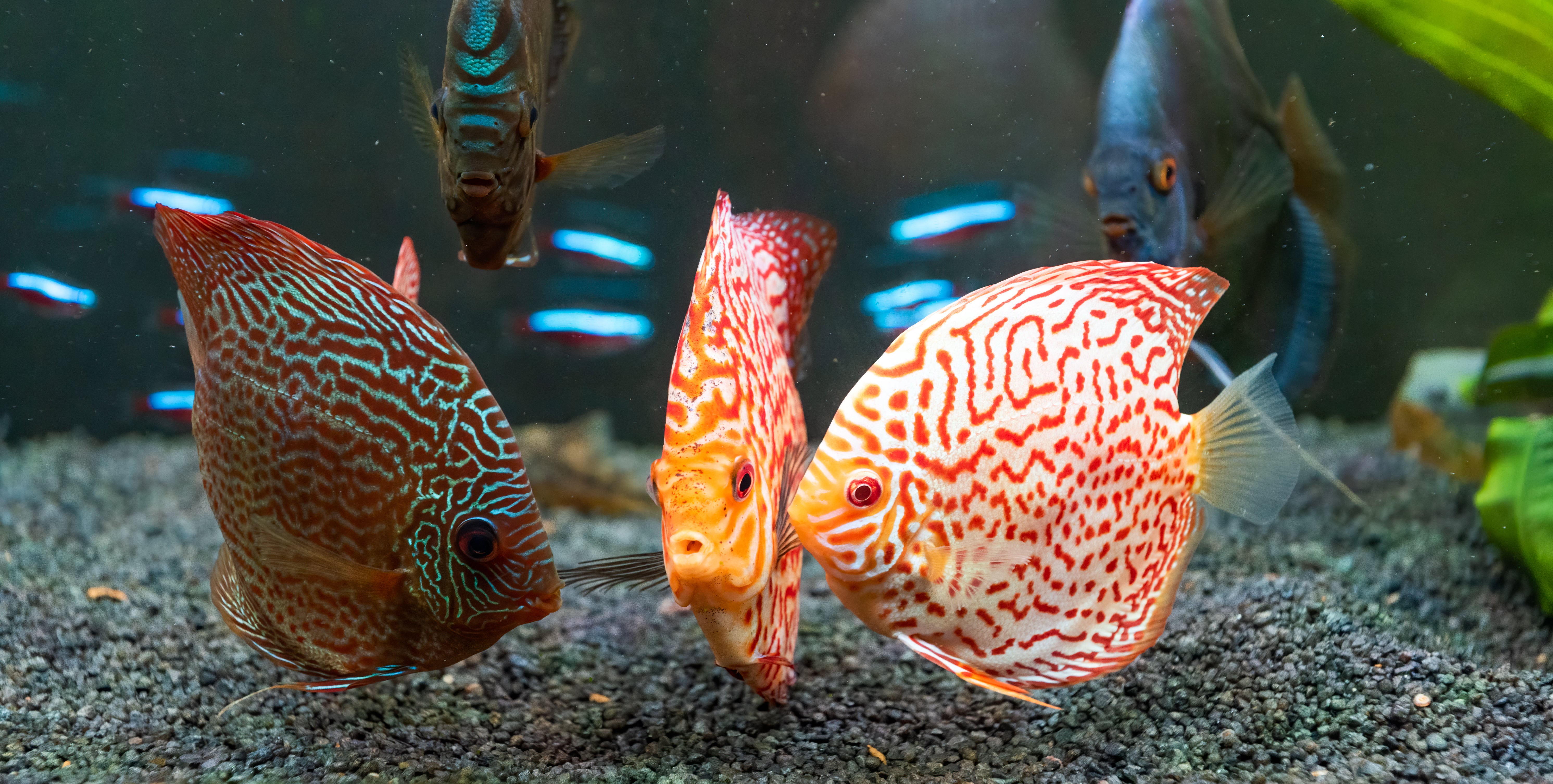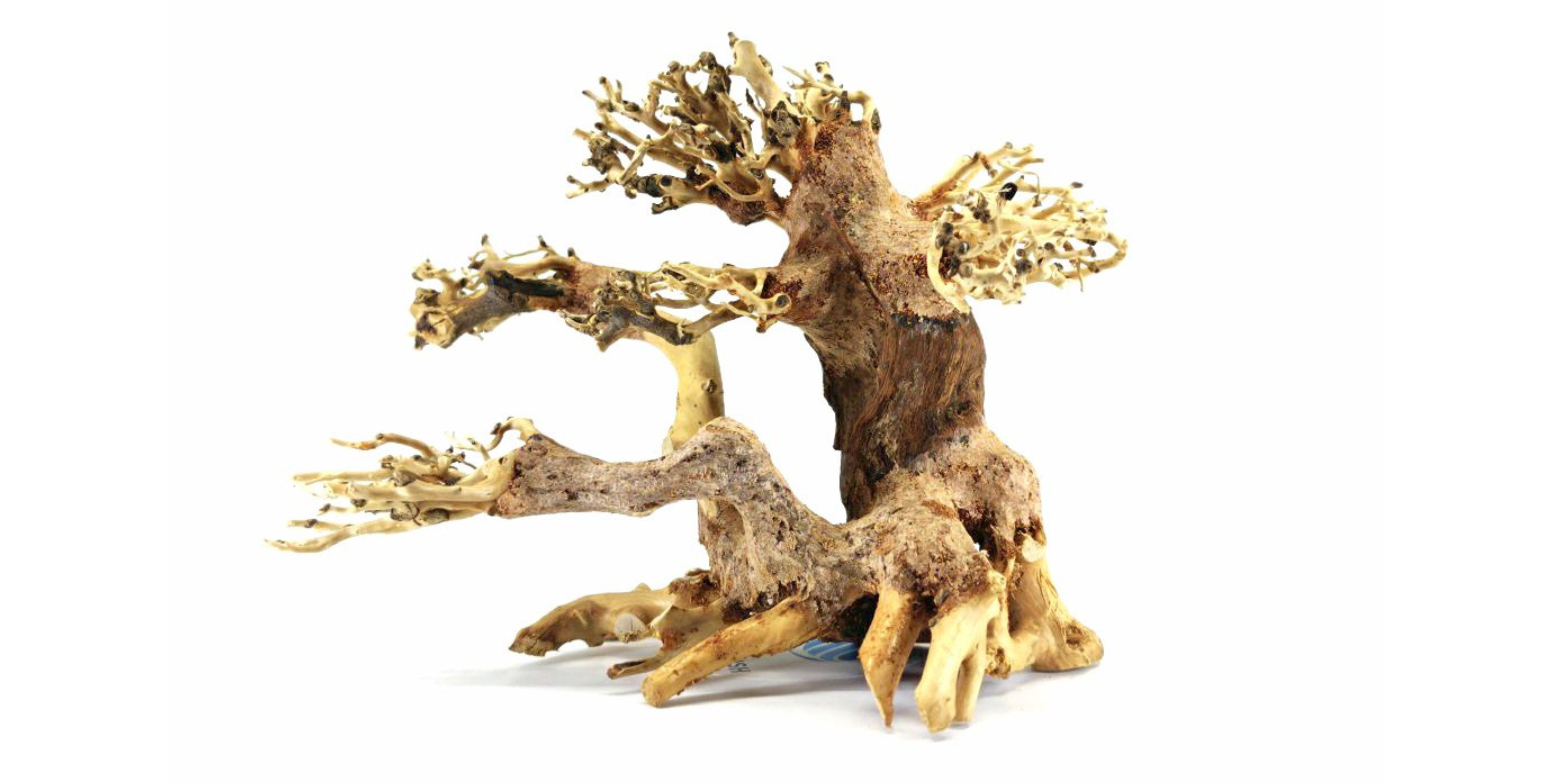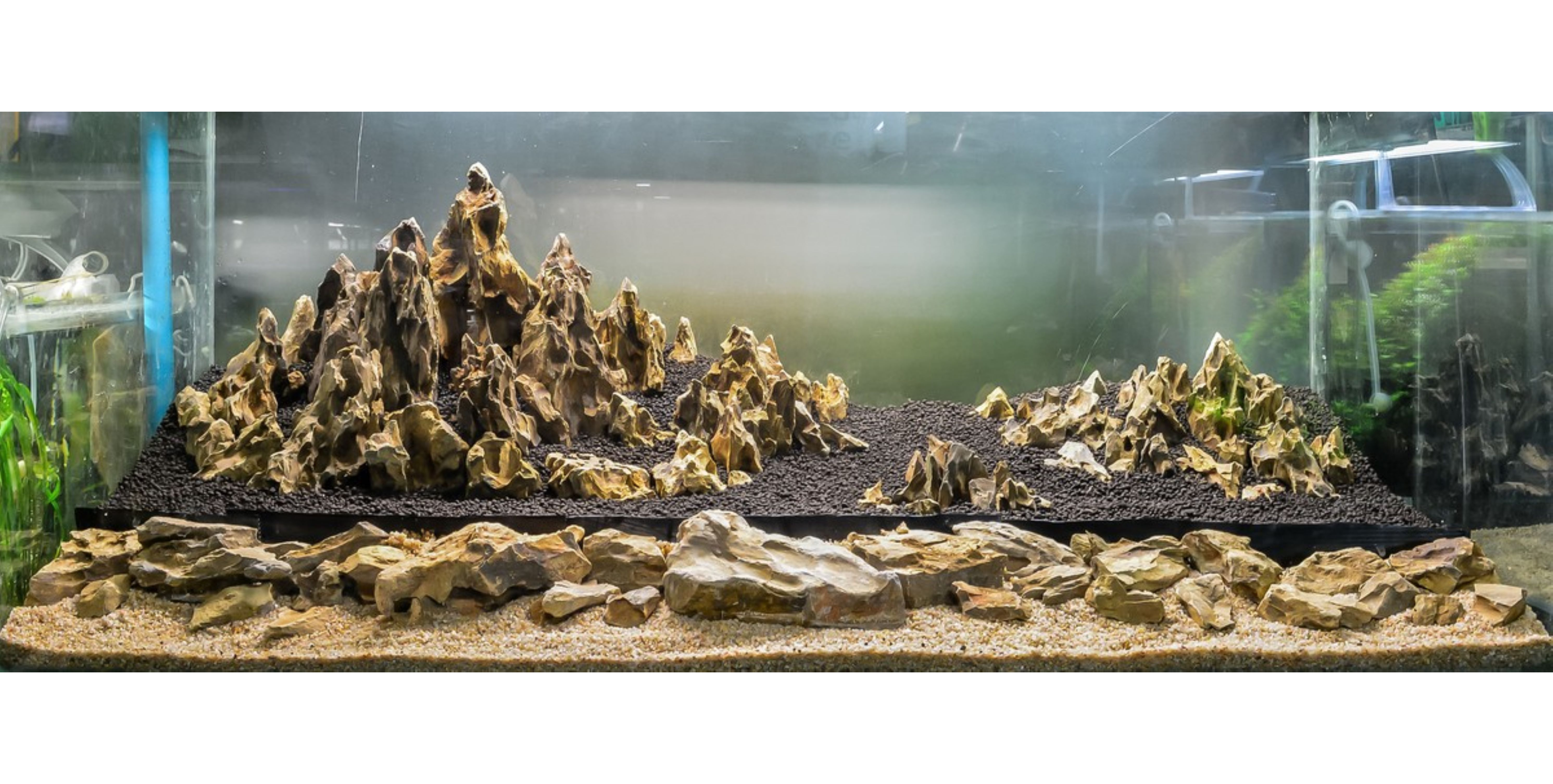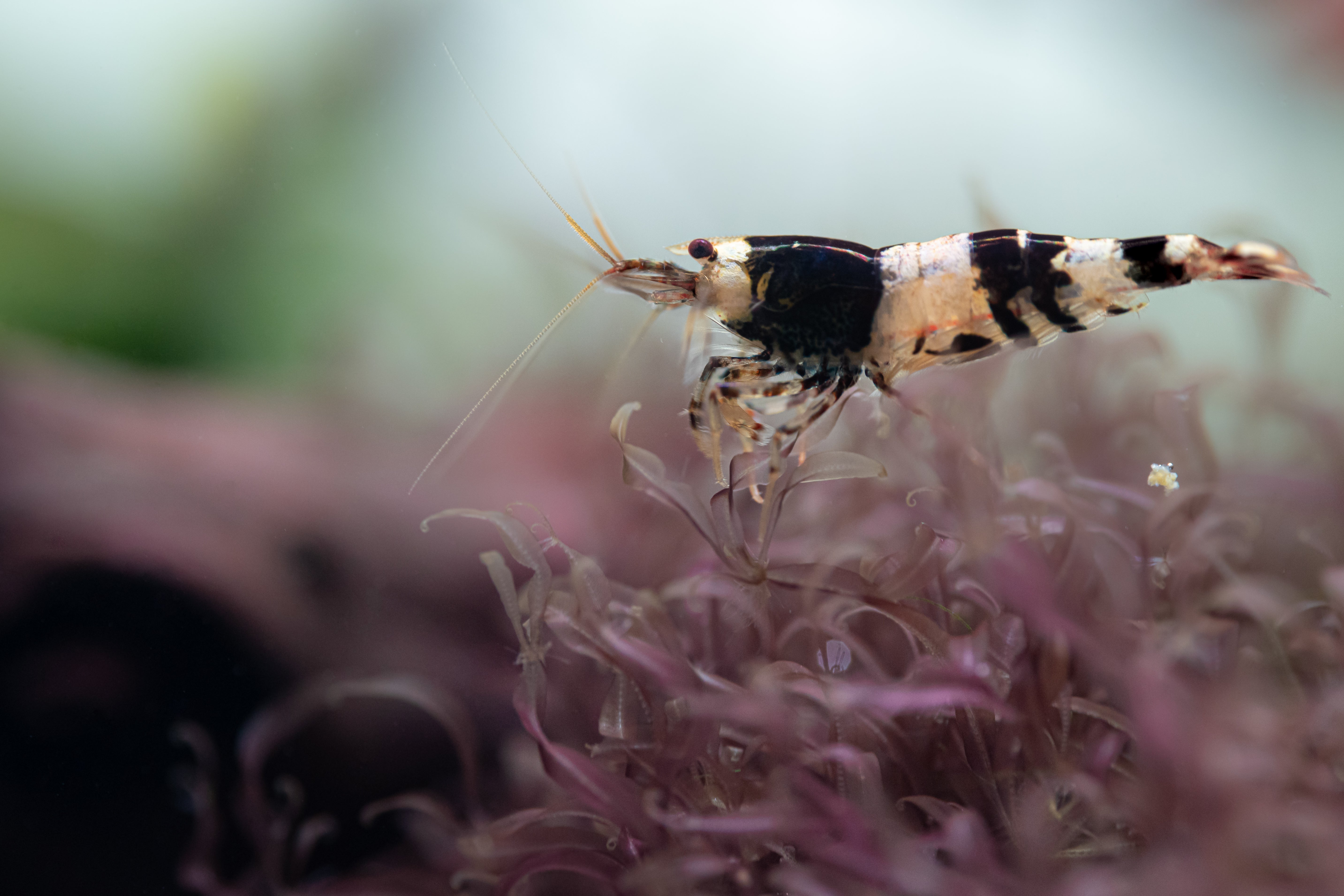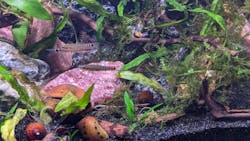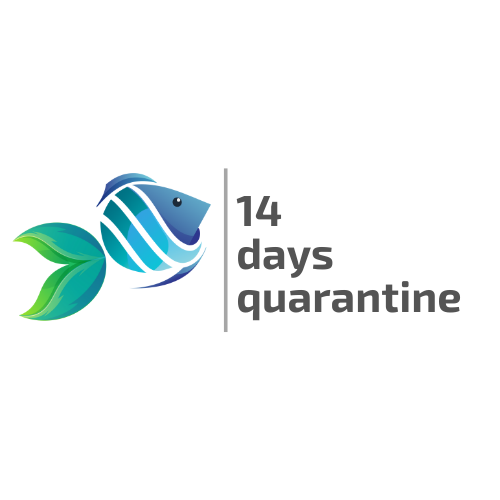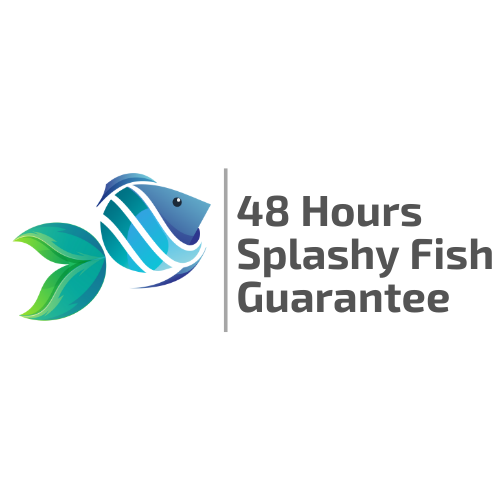
Crystal Black Shrimp
- In stock, ready to ship
- Inventory on the way
- Live Arrival Guarantee
- Get free shipping on non-live fish orders over $75 and live fish orders over $300.
- All our live fish, shrimp, snails are care with love and passion, when through minimum of 14 days quarantined and shipped from Splashy Fish facility in Springfield, Virginia, USA

This is only apply to live fish order.
What is Our Live Arrival Guarantee?
Benefit from our extensive experience in shipping live fish. In 2021, our records indicated a mere 0.5% dead-on-arrival (DOA) rate for all live fish orders, compared to the industry standard of 1.5%. These numbers translate to only 5 out of 1000 orders experiencing DOA fish.
At Splashy Fish, customer satisfaction is our priority. That's why we provide a 100% Live Arrival Guarantee on all animals shipped via USPS, UPS, or FedEx. Please note - Splashy Fish reserves the right to void Live Arrival Guarantee protection under the following circumstances:
- The customer has chosen USPS First Class Mail as a shipping method.
- The shipping address is a PO Box address
- The order was refused delivery by the customer.
- If the order is returned to the sender for any reason. For instance, an incorrect shipping address, an undeliverable address, etc.
- The order was held for pick up at USPS, UPS, and FedEx offices for longer than 24 hours after the last update on the tracking number.
- The Live Arrival Guarantee claim does not include all the requirements mentioned below
- The Live Arrival Guarantee claim is made after the claim period mentioned below.
- The animals are not in their original packaging
Live Arrival Guarantee Claim Period:
For Live Fish and other invertebrates, one and a half hours (1.5 hours) after the posted delivery time.
For Snails: 48 hours after the posted delivery time.
Steps to claim Splashy Fish's Live Arrival Guarantee:
- Take a picture of the shipping box and the shipping label.
- For live fish and other invertebrates: Please provide two pictures of each bag (containing the dead fish) upon arrival. Ensure the images display the bag in its original, unopened condition with the original rubber band intact
- For Snails: Position the snail in one corner of the tank. If the snail does not move within 48 hours, please take several pictures of the snail's opening
- Send an email to DOA@splashyfishstore.com with the subject line: DOA and Your Order Number, or message us on social media.
- In the body of the email, include your tracking number.
- The claim must be sent within the claim period mentioned above.
After submitting the required information, please allow us 1-3 business days to determine the cause of the issue. If the claim is valid and approved by our team, you will
- Receive a store credit for future purchases, excluding the shipping cost, of the dead-on-arrival fish
If the Live Arrival Guarantee claim does not meet all listed requirements, Splashy Fish reserves the right to reject it.
Shipping live animals and plants is a complex process, and temperature plays a crucial role in ensuring the safe and secure delivery of your order.
If the highest daytime temperature in your location and the lowest nighttime temperature here in Springfield, Virginia—where our facility is situated—fall below 40°F or exceed 90°F, we will proactively delay your order. This measure is taken to prioritize the well-being of the animals and plants.
For the safety of our living cargo and to protect your investment, we retain the right to suspend shipping as necessary due to extreme weather conditions. Our Splashy Fish team will assess the situation and determine if it is unsuitable to ship, considering the safety of the animals.
To stay informed or address any questions or concerns, feel free to reach out to our dedicated Splashy Fish Support team via email at support@splashyfishstore.com.
Once our team prints and packs your order, we'll notify you via email. This notification will include your tracking number and the expected arrival day. If you opt for UPS 2 Day shipping, your package should arrive within 2 days after shipment. Similarly, if you choose UPS 1 Day, your order will reach you the day after it is shipped. In the case of orders containing only plants or dry goods, they may be shipped via USPS, provided that this is the selected shipping option during checkout.
We ship all of the customer orders from our warehouse located in Springfield, VA. We pack and ship our orders depending on the orders with the exception of someday we cannot ship out live fish.
All Orders: will be shipped out from Monday to Thursday each week for overnight shipping by UPS.
Sunday: (Splashy Day) Today is the day we let our hard-working team members and our fish to destress and ready for the following week's shipment.
For more information regarding about shipping please visit us our Shipping Policy and Schedule
The Crystal Black Shrimp (Caridina cantonensis var. "Crystal Black") belongs to the Caridina shrimp genus in the family Atyidae. It is a selectively bred variant of the Bee Shrimp (Caridina cantonensis), known for its striking black and white coloration.
+1 in the title means that it is a free additional shrimp that we include when you purchase to cover for any Dead on Arrival during transit. We are not going to charge for any additional shrimp that is sent to customers above the amount customers purchase.
Crystal Black Shrimp Coloration
Elevate your aquarium with the striking beauty of Crystal Black Shrimp. These fascinating invertebrates display a bold contrast of deep black and crisp white patterns, creating a stunning visual appeal. Each freshwater shrimp showcases intricate markings that enhance the elegance of your aquatic setup, making them a prized choice for aquarists who appreciate refined aesthetics.
Crystal Black Shrimp Size
Though small in stature, Crystal Black Shrimp leave a lasting impression. Growing to an average size of up to 1.5 inches, these freshwater shrimp for aquariums are well-suited for nano and medium-sized aquariums. Their compact size allows them to explore every corner of the tank, adding dynamic movement and interest to the underwater environment.
Crystal Black Shrimp Behavior
Crystal Black Shrimp are peaceful and active scavengers, spending their time foraging and interacting with their surroundings. Their gentle nature makes them a joy to observe as they sift through the substrate and graze on biofilm. These Caridina shrimp contribute to tank cleanliness by consuming detritus and leftover food, promoting a healthier ecosystem.
Crystal Black Shrimp Care Requirements
To ensure the health and longevity of Crystal Black Shrimp, maintaining stable water conditions is essential. They thrive in well-established, densely planted aquariums with soft, slightly acidic water. Ideal parameters include a pH range of 6.5 to 7.5 and a temperature range of 72 to 78°F. A soft substrate and plenty of hiding spots will help mimic their natural habitat and encourage natural behaviors.
Crystal Black Shrimp Compatibility
Crystal Black Shrimp are best suited for peaceful community aquariums. They can coexist with other small, non-aggressive freshwater fish and invertebrates. However, caution is advised when selecting tankmates—avoid housing them with predatory species that may see them as food.
Crystal Black Shrimp Diet
Maintaining vibrant coloration and strong health in Crystal Black Shrimp requires a balanced diet. These omnivores thrive on a varied menu, including high-quality shrimp pellets, algae wafers, blanched vegetables, and supplemental calcium sources to support molting. A well-fed shrimp will exhibit rich coloration and active behavior.
Recommended Crystal Black Shrimp Tank Parameters
- Temperature: 72° - 78°F (22° - 26°C)
- pH: 6.5 – 7.5
- GH: 4 – 6 dGH
- KH: 1 – 2 dKH
- Minimum tank size: 5 gallons
See more details about Care Guide for Caridina Shrimp
Why Should You Buy Crystal Black Shrimp at Splashy Fish Store?
At Splashy Fish tropical fish store, our Crystal Black Shrimp for sale and other freshwater shrimp for sale are quarantined 14 days before shipping to ensure the best quality to our beloved customers. You can buy Crystal Black Shrimp online or visit our aquarium store in Virginia for more freshwater fish for sale, betta fish for sale, aquatic shrimp for sale, live aquatic plants for sale, and aquarium supplies.
Crystal Black Shrimp Frequently Asked Questions (FAQs)
What is the biggest size of Crystal Black Shrimp in home aquarium?
Crystal Black Shrimp (Caridina cantonensis var. "Crystal Black") typically reach a maximum size of 1.5 inches (3.8 cm) in a well-maintained home aquarium. Their growth depends on factors such as diet, water quality, and genetics. Providing a stable environment with high-quality food and proper care can help them reach their full size.
The differences between Black King Kong Shrimp vs Crystal Black Shrimp?
Both Black King Kong Shrimp and Crystal Black Shrimp belong to the Caridina genus but have key differences:
- Coloration: Black King Kong Shrimp have a solid, deep black body with little to no white markings, whereas Crystal Black Shrimp display bold black and white patterns.
- Genetics: Black King Kong Shrimp originate from selective breeding of Taiwan Bee Shrimp, while Crystal Black Shrimp are a variant of the Bee Shrimp (Caridina cantonensis).
- Care Level: Black King Kong Shrimp are more delicate and require softer water (low GH/KH), whereas Crystal Black Shrimp are slightly hardier but still need stable parameters.
- Price: Black King Kong Shrimp are generally more expensive due to their rarity and difficulty in breeding compared to Crystal Black Shrimp.
How often should I feed Crystal Black Shrimp?
Feed Crystal Black Shrimp once per day with a small portion of food they can consume within 2-3 hours. Overfeeding can lead to water quality issues, so remove any uneaten food after a few hours. Their diet should include:
- Shrimp-specific pellets or granules
- Algae wafers and biofilm (natural food source)
- Blanched vegetables (zucchini, spinach, kale)
- Calcium-rich foods to support healthy molting
The Marvelous World of Crystal Black Shrimp: A Guide to Their Enchanting Beauty and Care
Experience the enchanting beauty and fascinating world of Crystal Black Shrimp. These captivating creatures are the gems of the aquarium hobby, renowned for their striking appearance and delicate nature. In this comprehensive guide, we will take you on a journey through the marvelous world of Crystal Black Shrimp, showcasing their unique characteristics, care requirements, and the joy they bring to aquarists around the globe. Known for their deep black coloration and shimmering metallic sheen, Crystal Black Shrimp are a stunning addition to any aquarium. Their intricate patterns and contrasting white stripes make them truly stand out amongst other freshwater species. Whether you are a seasoned aquarist or just starting out, this guide will provide you with all the information you need to create the perfect environment for these exquisite creatures. From tank setup and water parameters to diet and breeding, we will cover every aspect of Crystal Black Shrimp care, ensuring you have the knowledge and tools to keep them thriving. Discover the wonders of this captivating species and unlock the secrets to creating a thriving Crystal Black Shrimp community in your home aquarium. Buckle up and get ready for an extraordinary journey into the marvelous world of Crystal Black Shrimp!
The Unique Beauty of Crystal Black Shrimp
The Crystal Black Shrimp (Caridina cantonensis) is a freshwater shrimp species that has captured the hearts of aquarists worldwide. Their striking black and white coloration, combined with their translucent bodies, creates a mesmerizing visual effect that is hard to ignore. These freshwater shrimp are often compared to living jewels, adding a touch of elegance and sophistication to any aquarium.
What makes Crystal Black Shrimp truly unique is their intricate patterns. The contrast between their deep black bodies and bright white stripes creates a stunning visual appeal that is both bold and delicate. This coloration is not just for show—it also serves as a natural camouflage, helping them blend into their environment and avoid predators.
In addition to their beauty, Crystal Black Shrimp are known for their peaceful and social nature. They are active scavengers, constantly foraging for food and interacting with their surroundings. Watching them navigate their environment is a delight, making them a favorite among hobbyists.
Understanding the Different Grades of Crystal Black Shrimp
When it comes to Crystal Black Shrimp, not all are created equal. These shrimp are graded based on the intensity and clarity of their coloration, as well as the consistency of their patterns. Understanding these grades is essential if you’re looking to purchase high-quality shrimp or breed them for specific traits.
Here’s a breakdown of the most common grades:
- C-Grade: These shrimp have a less defined pattern, with broken or uneven stripes. The black coloration may also appear faded or patchy. While they are still beautiful, they are considered the lowest grade.
- B-Grade: B-grade shrimp have more defined patterns, with clearer white stripes and more consistent black coloration. They are a step up from C-grade and are a popular choice for hobbyists.
- A-Grade: A-grade shrimp exhibit bold, solid black coloration with crisp, unbroken white stripes. They are highly sought after for their striking appearance.
- S-Grade: S-grade shrimp are the cream of the crop. Their black coloration is deep and uniform, and their white stripes are perfectly defined. These shrimp are often used for breeding to produce high-quality offspring.
- SS-Grade: The highest grade available, SS-grade shrimp have an almost pure black body with minimal white markings. They are rare and highly prized by collectors.
When searching for Crystal Black Shrimp for sale, it’s important to consider the grade that best suits your needs and budget. Higher-grade shrimp may come with a higher price tag, but their beauty and breeding potential make them a worthwhile investment.
Setting Up the Perfect Tank for Crystal Black Shrimp
Creating the ideal environment for Crystal Black Shrimp is crucial to their health and well-being. These shrimp are sensitive to changes in water conditions, so a well-planned tank setup is essential.
Tank Size
A 10-gallon tank is the minimum recommended size for keeping Crystal Black Shrimp. However, a larger tank (20 gallons or more) is preferable, as it provides more stable water parameters and ample space for the shrimp to thrive.
Substrate
Crystal Black Shrimp thrive in tanks with active substrates like 2Hr Aquarist Feast Aquasoil or UNS Controsoil. These substrates help maintain a slightly acidic pH, which is ideal for these shrimp. Avoid using inert substrates like gravel, as they do not provide the necessary buffering capacity.
Filtration
A sponge filter is the best choice for a Crystal Black Shrimp tank. It provides gentle filtration without creating strong currents that could stress the shrimp. Additionally, sponge filters are safe for shrimp fry, making them ideal for breeding setups.
Decorations and Hiding Spots
Provide plenty of hiding spots using driftwood, rocks, and live plants. Crystal Black Shrimp are shy creatures and appreciate having places to retreat. Plants like Java moss, Anubias, and Marimo moss balls are excellent choices, as they also serve as a natural food source.
Water Parameters and Care Requirements for Crystal Black Shrimp
Maintaining stable water parameters is critical for Crystal Black Shrimp's health. The ideal conditions include:
- Temperature: 68-74°F (20-23°C)
- pH Level: 5.5-6.5
- GH (General Hardness): 4-6 dGH
- KH (Carbonate Hardness): 0-2 dKH
- TDS (Total Dissolved Solids): 100-200 ppm
Frequent water changes (10-20% weekly) with remineralized RO (reverse osmosis) water are necessary to maintain stable conditions.
Feeding and Nutrition for Crystal Black Shrimp
Crystal Black Shrimp are omnivorous scavengers that feed on biofilm, algae, and decaying plant matter. However, supplementing their diet with high-quality shrimp foods will ensure they receive all the nutrients they need.
- Staple Foods: Shrimp pellets, algae wafers, and blanched vegetables like zucchini, spinach, and cucumber.
- Protein Sources: Bloodworms, brine shrimp, and daphnia (feed sparingly to avoid overloading the tank with protein).
- Supplements: Mineral supplements like calcium and magnesium are essential for healthy molting and shell development.
Feed your shrimp in small amounts once or twice a day, removing any uneaten food after a few hours to prevent water contamination.
Common Health Issues and How to Prevent Them in Crystal Black Shrimp
While Crystal Black Shrimp are relatively hardy, they can be susceptible to certain health issues if their care requirements are not met.
- Failed Molting: Caused by insufficient calcium or magnesium in the water. Ensure proper water parameters and provide mineral supplements.
- Bacterial Infections: Often a result of poor water quality. Maintain clean water and avoid overfeeding.
- Parasites: Look out for signs of parasitic infections, such as lethargy or unusual behavior. Quarantine new shrimp before adding them to the main tank.
Breeding Crystal Black Shrimp: Tips and Considerations
Breeding Crystal Black Shrimp can be both rewarding and challenging. To encourage successful breeding:
- Maintain stable water parameters and a stress-free environment.
- Provide a protein-rich diet to enhance reproductive health.
- Keep a well-established tank with biofilm for baby shrimp to feed on.
- Separate higher-grade offspring for selective breeding programs.
Crystal Black Shrimp Tank Compatibility
Tank Mates of Crystal Black Shrimp
Freshwater Shrimp
1. Amano Shrimp (Caridina multidentata):
- Size: 2 inches (5 cm) long.
- Behavior: Amano shrimp are large enough not to be preyed upon by CBS but are peaceful and not territorial. They are great algae-eaters and work well in tanks with shrimp like CBS.
- Water Requirements: Amanos prefer similar water parameters as Crystal Black Shrimp (soft, acidic to neutral water, temperatures between 68-78°F / 20-26°C).
- Notes: Although they’re peaceful, Amano shrimp can sometimes compete for food. Make sure there is plenty of food for all the shrimp in the tank.
2. Cherry Shrimp (Neocaridina davidi):
- Size: 1.5 inches (3.8 cm) long.
- Behavior: Cherry shrimp come in various colors, including red, yellow, and blue. Neocaridina shrimp are peaceful and non-aggressive, making them suitable companions for CBS. However, they breed prolifically, which could lead to competition for food if not managed properly.
- Water Requirements: They thrive in slightly harder water than CBS, but they still prefer similar conditions (slightly acidic to neutral, around 72°F / 22°C).
- Notes: Cherry shrimp may occasionally crossbreed with CBS, but the resulting offspring may not have the desirable traits of either species.
3. Ghost Shrimp (Palaemonetes paludosus):
- Size: 1.5-2 inches (3.8-5 cm) long.
- Behavior: Ghost shrimp are transparent and peaceful. They won’t bother CBS but can occasionally scavenge food in the tank, ensuring the environment stays clean. They do well in similar water conditions to CBS.
- Notes: Ghost shrimp are generally peaceful, though they can be a bit more active than CBS, so ensure the tank has enough hiding places for both species.
Freshwater Fish
1. Neon Tetras (Paracheirodon innesi):
- Size: 1.5 inches (4 cm) long.
- Behavior: Neon Tetras are peaceful and small enough not to pose a threat to CBS. These Tetras swim in schools, so having 5-6 or more in the tank ensures they remain calm and not overly curious about the shrimp.
- Water Requirements: Soft, slightly acidic water (pH 6.0-7.0) and temperatures around 70-75°F (21-24°C).
- Notes: Neon Tetras won’t harm CBS, though they might nibble at the babies if they can catch them. However, adult CBS are usually safe.
2. Harlequin Rasboras (Trigonostigma heteromorpha):
- Size: 2 inches (5 cm) long.
- Behavior: Harlequin Rasboras are non-aggressive and peaceful, making them excellent companions for CBS. These Rasbora fish have a calming, schooling nature that won’t disturb the shrimp.
- Water Requirements: Similar to CBS, they prefer soft water (pH 6.0-7.5) and temperatures between 72-80°F (22-27°C).
- Notes: Harlequin Rasboras are not usually predatory toward shrimp but might nibble on shrimp larvae if food is scarce.
3. Otocinclus Catfish (Otocinclus spp.):
- Size: 2 inches (5 cm) long.
- Behavior: Otocinclus are small algae eaters, perfect for shrimp tanks. They are gentle and won’t harm your CBS. They are also excellent for keeping algae in check, which benefits the tank’s overall cleanliness.
- Water Requirements: Soft, slightly acidic to neutral water (pH 6.0-7.0) and temperatures between 72-79°F (22-26°C).
- Notes: Otocinclus Catfish are peaceful and spend their time grazing on algae, leaving the shrimp alone. They do best in groups.
4. Corydoras Catfish (Corydoras spp.):
- Size: 2-3 inches (5-7.5 cm) long.
- Behavior: Corydoras are peaceful bottom dwellers. They won’t disturb CBS and help with scavenging leftover food from the tank bottom. These Cory Catfish are gentle, non-predatory, and can be a good choice for community tanks.
- Water Requirements: Similar to CBS (pH 6.0-7.5, temperatures 72-78°F / 22-26°C).
- Notes: Corydoras Catfish are peaceful and won’t compete with CBS for food. However, because they are bottom dwellers, make sure to provide enough food for both species.
Other Invertebrates
1. Nerite Snails (Neritina spp.):
- Size: 1 inch (2.5 cm) in diameter.
- Behavior: Nerite snails are excellent algae eaters and do not pose a threat to CBS. These are peaceful and can coexist in the same tank. Their small size and non-aggressive nature make them ideal companions.
- Water Requirements: They do best in soft to moderately hard water with a pH of 7.0-7.5 and temperatures between 72-78°F (22-26°C).
- Notes: Nerite snails do not breed in freshwater, so you won’t end up with a snail population explosion.
2. Malaysian Trumpet Snails (Melanoides tuberculata):
- Size: Up to 2 inches (5 cm) long.
- Behavior: These freshwater snails burrow into the substrate and help aerate the soil. They’re peaceful and won’t harm CBS, but they can reproduce rapidly under favorable conditions. You’ll need to monitor their population.
- Water Requirements: Soft to moderately hard water with a pH of 6.5-7.5, and temperatures between 72-78°F (22-26°C).
- Notes: MTS are good tank mates as they help with cleaning, but their rapid breeding might become an issue in a small tank.
Species Need to Avoid
1. Large Predatory Fish (e.g., Cichlids, Goldfish, Large Catfish):
- Why Avoid: Large fish like Cichlids or Goldfish are aggressive and might see the shrimp as a snack. Even if they don't directly hunt the shrimp, they can easily outcompete them for food or disrupt their peaceful environment.
- Examples: Oscars, African Cichlids, Goldfish, and any large, predatory fish.
2. Aggressive Fish (e.g., Bettas, Barbs, Angelfish):
- Why Avoid: Aggressive species like Bettas or Angelfish can be territorial and will chase and attack shrimp, especially when they’re breeding or stressed. Betta fish, in particular, are notorious for harassing small tank mates.
- Examples: Betta fish, Tiger Barbs, and angelfish.
3. Crayfish:
- Why Avoid: Crayfish are aggressive and much larger than shrimp. They will actively hunt shrimp, especially during molting or when they are weak. freshwater crayfish can easily crush or eat smaller shrimp.
- Examples: All crayfish species, especially larger ones like the Procambarus species.
Enhance Crystal Black Shrimp with Aquatic Plants
Benefits of Aquatic Plants for Crystal Black Shrimp:
- Hiding Spots for CBS: Shrimp, especially CBS, appreciate plenty of hiding spaces where they can feel safe, especially during molting. Dense plants and plant roots provide excellent hiding spots.
- Natural Filtration: Plants help filter the water by absorbing excess nutrients, particularly nitrogen compounds like nitrates. This helps maintain good water quality, which is crucial for shrimp health.
- Algae Control: Certain plants, like fast-growing ones, help outcompete algae, keeping the tank clean and providing better conditions for your shrimp.
- Nutrient Source: While CBS don’t eat plants, certain plants provide additional nutrients that can benefit their overall health and promote successful breeding.
Best Aquatic Plants for Crystal Black Shrimp Tanks
1. Java Moss (Taxiphyllum barbieri):
- Size: Grows to fill areas with dense mats.
- Care: Low-maintenance, adaptable to various water conditions.
- Benefits: Java moss provides excellent coverage for CBS, offering them a place to hide and molt safely. The dense structure of Java moss can also house microorganisms (biofilm), which CBS may graze on. Java moss thrives in soft, acidic water, making it an ideal choice for CBS tanks.
- Placement: Can be attached to rocks, driftwood, or left to float.
- Growth Rate: Medium to fast-growing, so it will need trimming to avoid overgrowth.
2. Anubias (Anubias barteri):
- Size: Typically 4–8 inches (10–20 cm).
- Care: Easy to care for, requires low to moderate light, and can grow in a variety of conditions.
- Benefits: Anubias is hardy and non-demanding, making it an excellent plant for shrimp tanks. Its broad, flat leaves provide a place for biofilm to form, which CBS can graze on. It’s also slow-growing, so it won’t overwhelm the tank.
- Placement: Best attached to rocks or driftwood (do not bury the rhizome in substrate).
- Growth Rate: Slow-growing, so it won’t need much trimming.
3. Java Fern (Microsorum pteropus):
- Size: 6–12 inches (15–30 cm) tall.
- Care: Requires low to moderate lighting and is very easy to grow.
- Benefits: Like Java moss, Java fern is perfect for shrimp tanks as it provides dense coverage. The long leaves can host biofilm for CBS to graze, and it’s tough enough to handle the less-than-perfect water conditions that may occur in shrimp tanks.
- Placement: It thrives when attached to driftwood or rocks.
- Growth Rate: Slow to medium, so it won’t outcompete other plants.
4. Hornwort (Ceratophyllum demersum):
- Size: Can grow up to 12–15 inches (30–38 cm) or more.
- Care: Fast-growing and thrives in soft, slightly acidic water.
- Benefits: Hornwort is a floating or rooted plant that can create dense undergrowth where CBS can hide. The rapid growth of Hornwort helps absorb excess nutrients and outcompete algae. It can also provide a refuge for young shrimp.
- Placement: Can be left floating or anchored to the substrate.
- Growth Rate: Fast-growing, so it needs regular pruning.
5. Cryptocoryne (Cryptocoryne spp.):
- Size: 3–8 inches (7–20 cm), depending on the species.
- Care: Thrives in low to medium light and doesn’t require CO2 injection.
- Benefits: Cryptocoryne is a popular aquatic plant for shrimp tanks due to its tolerance to various water conditions. It has wide, textured leaves that provide excellent hiding spots for CBS. The plant also grows slowly, which helps it coexist well with shrimp.
- Placement: Best planted in the substrate.
- Growth Rate: Slow to medium.
6. Water Sprite (Ceratopteris thalictroides):
- Size: Can grow up to 8–12 inches (20–30 cm) tall.
- Care: Low-maintenance and adaptable to most water conditions.
- Benefits: Water sprite grows fast and helps to absorb excess nutrients in the water, preventing algae blooms. Its delicate leaves provide hiding spots for shrimp and its rapid growth can be pruned to maintain balance in the tank.
- Placement: Can be rooted in the substrate or left to float.
- Growth Rate: Fast-growing.
7. Marimo Moss Balls (Aegagropila linnaei):
- Size: Typically 2–4 inches (5–10 cm) in diameter.
- Care: Very low-maintenance and adaptable to a variety of tank conditions.
- Benefits: Marimo moss ball are excellent for shrimp tanks because they help to maintain clean water by absorbing excess nutrients. They also provide an easy-to-care-for plant option that won’t take up much space. CBS may also graze on the biofilm that grows on these moss balls.
- Placement: Floating or placed on the substrate.
- Growth Rate: Slow-growing.
8. Amazon Sword (Echinodorus spp.):
- Size: Can grow up to 20–30 inches (50–75 cm) tall.
- Care: Requires moderate to high light and regular nutrient supplementation.
- Benefits: Amazon swords are great for creating a lush backdrop or midground in a larger shrimp tank. Their large, broad leaves can host biofilm, and they also help absorb excess nutrients. CBS can use the dense leaves to hide and molt in peace.
- Placement: Requires substrate to anchor roots.
- Growth Rate: Fast-growing with proper care.
Conclusion
Crystal Black Shrimp are truly one of the most fascinating and beautiful freshwater invertebrates in the aquarium hobby. Their striking patterns, delicate nature, and intriguing behaviors make them a prized addition to any aquascape. With the right care, stable water parameters, and suitable tank mates, these shrimp can thrive and even breed in captivity. Whether you are looking for Crystal Black Shrimp for sale or planning to start a breeding project, this guide equips you with all the knowledge needed to maintain a healthy, vibrant shrimp colony.


